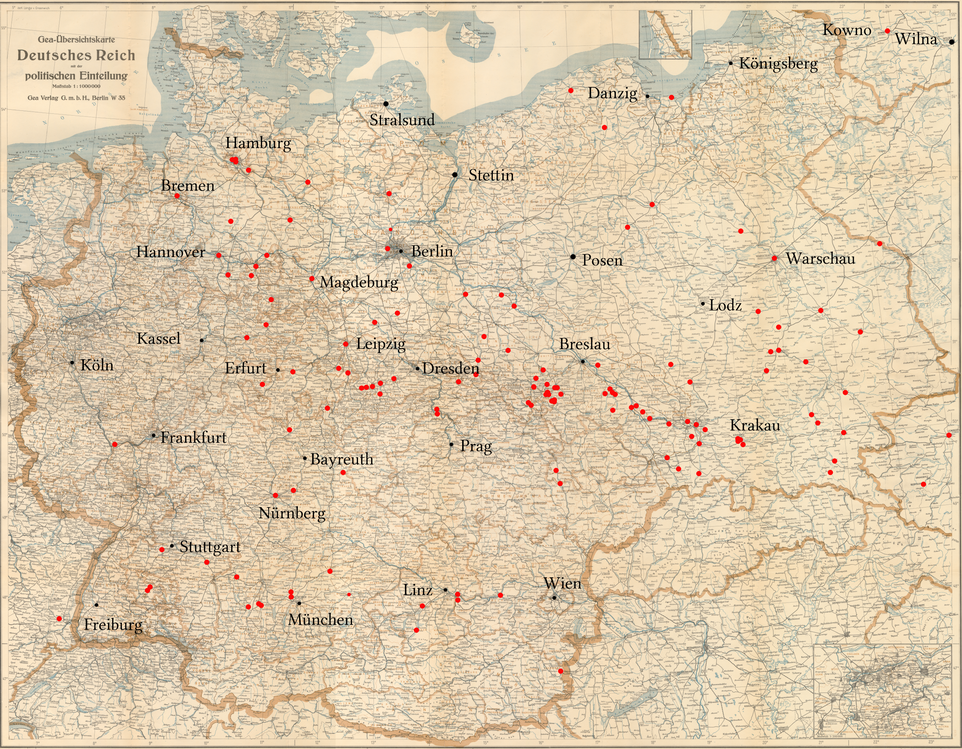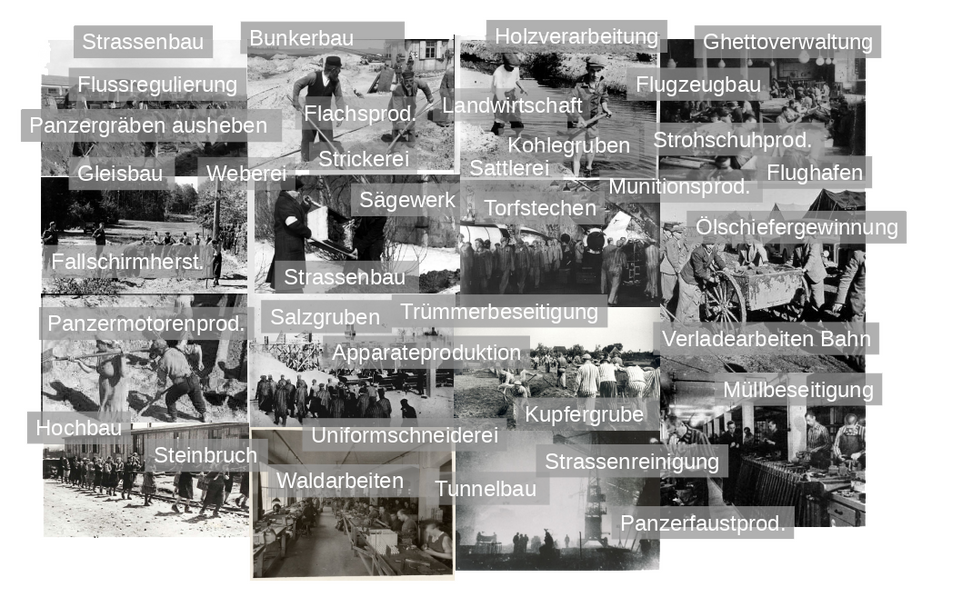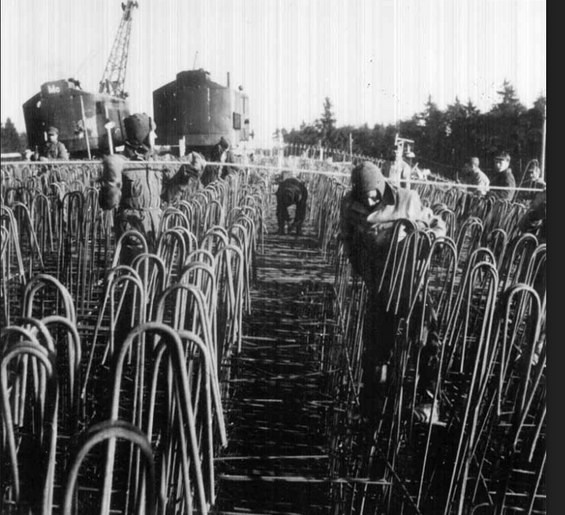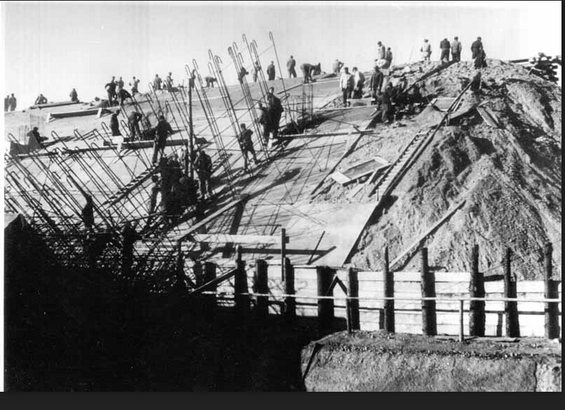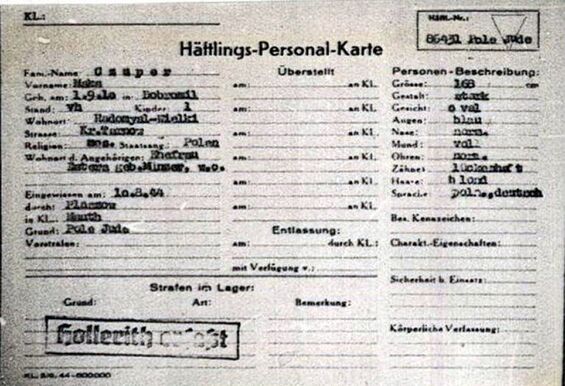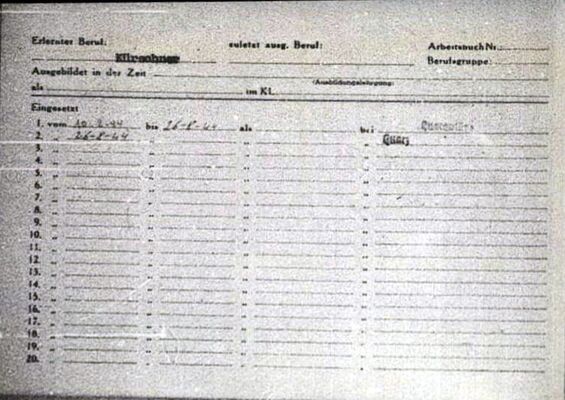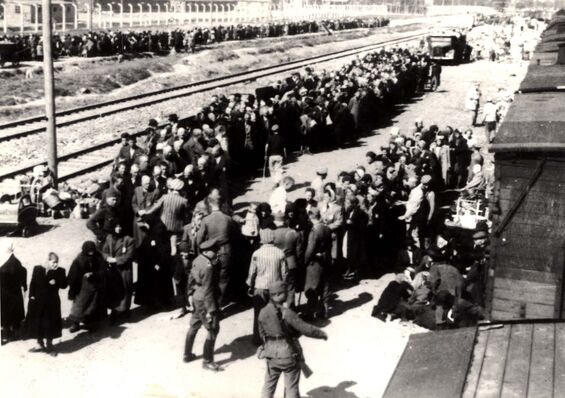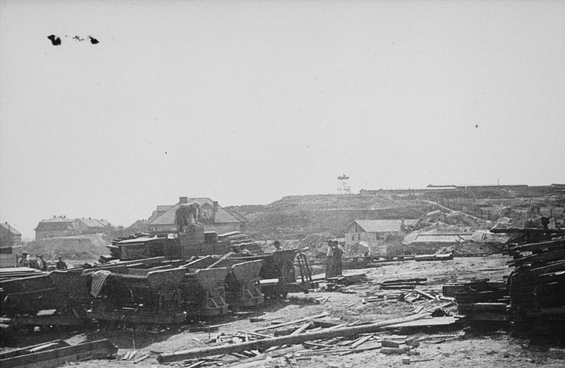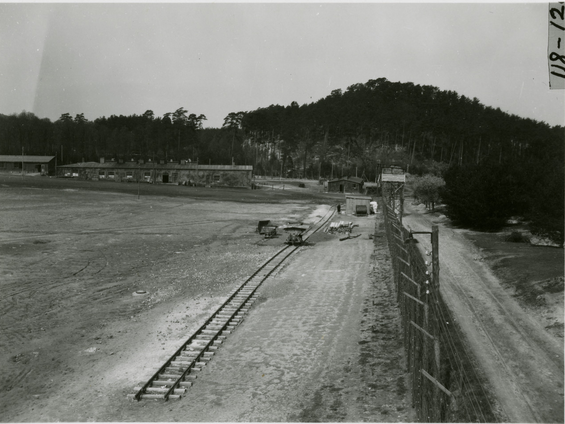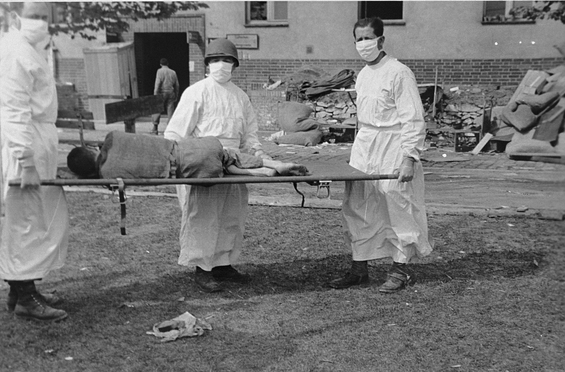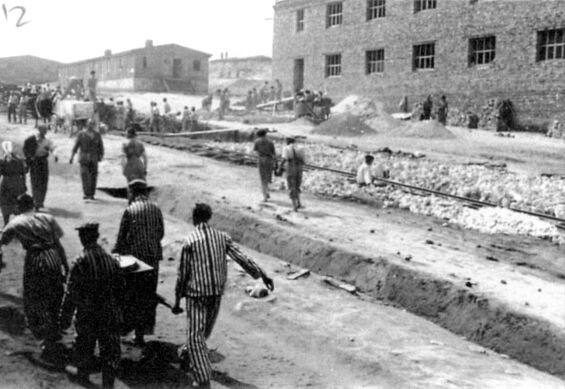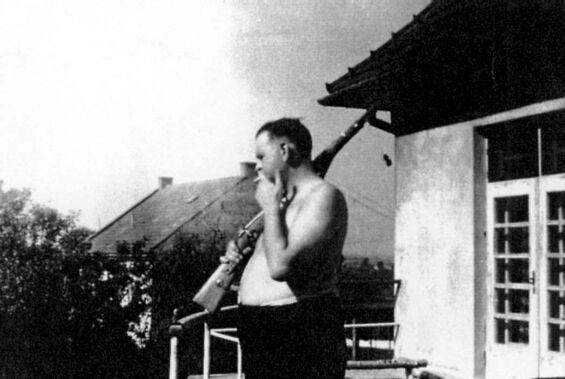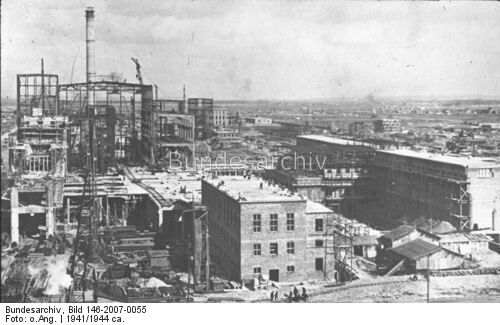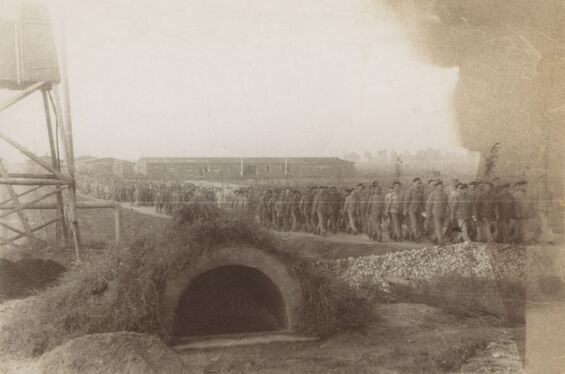Map of forced Labour and Concentration Camps mentioned
List of forced labour camps in which some of the claimants were already forced to work in mid-1940:
Tschenstochau (51), Skarzysko-Kamienna (33), Plaszow (24), Pionki (8), Deblin (7), Blizyn (6), Radom (5), Mielec (5), Blechhammer (5), Piotrkow-Trybunalski (4), Klettendorf (4), Neustadt (3), Lublin (3), Lemberg (3), Krakau (3), Brande (3), Borki-Wielki (3), Tluste (2), Tarnopol (2), Szolnok (2), Szebnie (2), Rozanowka (2), Reichshof (2), Pustkow (2), Parzymiechy (2), Ottmuth (2), Lisowce (2), Landeshut (2), Krosno (2), Kielce (2), Großsarne (2), Geppersdorf (2), Faulbrück (2), Drohobycz (2), Bunzlau (2), Bolkenhain (2), Annaberg (2), Wilna-HKP 562 (2), Nowogrodek (2), Zwittau (1), Ziezmariai (1), Zaslow (1), Zagorze (1), Wolanow (1), Wilejka (1), Wiesau (1), Waldenburg (1), Szegedin (1), Strassburg (1), Starachowic (1), Stanislawow (1), Stalowa-Wola (1), St (1), Sosnowitz (1), Sopron (1), Seibersdorf (1), Schachendorf (1), Saybusch (1), Sakrau (1), Rzecmir (1), Riga (1), Rejowiec (1), Radomyśl (1), Prokoczyn (1), Ostrowiec (1), Ober-Altstadt (1), Nowogrodek (1), Neusalz (1), Nasze (1), Nagybanya (1), Munkacs (1), Miskolc (1), Miechow (1), Menzk (1), Markstädt (1), Malken) (1), Lockenhaus (1), Lichtenwörth (1), Leipzig (1), Langenbielau (1), Landsberg (1), Krychow (1), Krusznin (1), Kosicze (1), Komarom (1), Kleinmangerdorf (1), Klei (1), Kassel (1), Kamionka (1), Kaišiadorys (1), Jenisow (1), Jenischow (1), Jedlitze (1), Jaslo (1), Jaradow (1), Janow (1), Halbstadt (1), Gunz (1), Grünberg (1), Groeditz (1), Gogolin (1), Gabersdorf (1), Falkenberg (1), Dworzec (1), Dukla (1), Donnerskirchen (1), Demblin (1), Budzyn (1), Budapest (1), Brätz (1), Boryslaw (1), Bor (1), Biechow (1), Beuthen (1), Bernsdorf (1), Auenrode (1), Andrejew (1).
List of concentration camps and their satellite camps in which claimants were imprisoned. Some camps are mentioned in this and the previous list, as forced labour camps were often taken over as satellite camps of concentration camps, e.g. Grünberg, Falkenberg:
-
Auschwitz Stammlager und Außenlager (196): Althammer, Auschwitz II Birkenau, Blechhammer, Gleiwitz, Golleschau, Günthergrube, Hindenburg, Jawischowitz, Neu-Dachs (Jaworzno), Laurahuette, Auschwitz III Monowitz, Trzebinia, Zigeunerlager
-
Buchenwald (93): Allendorf, Altenburg, Berga-Elster, Crawinkel, Elsnig, Holzen, Laura, Leipzig-Schoenefeld, Magdeburg, Markkleeberg, Meuselwitz, Neustadt, Niederorschel, Ohrdruf, Rehmsdorf, Schlieben, Sonneberg-West, Langenstein-Zwiberge
-
Bergen-Belsen (82);
-
Gross-Rosen und seine Nebenlager (78): Annaberg, Birnbaeumel, Bruennlitz, Bunzlau, Christianstadt, Doernhau, Falkenberg, Friedland, Fuenfteichen, Fuerstenstein, Gabersdorf, Gablonz, Georgenthal, Goerlitz, Grünberg, Hirschberg, Kaltwasser, Langenbielau, Ludwigsdorf, Maerzbachtal, Metzdorf,
Mittelstein, Neusalz, Ober-Altstadt, Parschnitz, Peterswaldau, Reichenbach, Waldenburg, Wolfsberg, Wuestegiersdorf, Zittau -
Stutthof (60): Argenau, Burggraben, Chinow, Doerbeck, Elbling, Freudendorf, Lauenburg, Malken, Masuriczyk, Praus, Praust, Sophienwald, Sophienwall, Stolp, Thorn, Truns
-
Mauthausen (57): Ebensee, Gunskirchen, Gusen, Linz, Melk, St.Valentin
-
Neuengamme und Außenlager (52): Ahlem, Aurich-Engerhafe, Braunschweig, Bremen-Hindenburgkaserne, Bremen-Obernheide, Fallersleben, Hamburg, Hamburg-Harburg, Hamburg-Langenhorn, Hamburg-Ochsenzoll, Hamburg-Sasel, Hamburg-Stülkenwerft,Hannover, Hannover-Mühlenberg, Helmstedt-Beendorf, Hildesheim, Lübecker Bucht, Salzwedel, Sandbostel, Uelzen, Vechelde, Watenstedt, Woebbelin
-
Flossenbuerg (46): Ansbach, Freiberg, Gundelsdorf, Helmbrechts, Hersbruck, Hohenstein, Leitmeritz, Mehltheuer, Neunburg?, Nuernberg, Oederan, Regensburg, Siegmar-Schoenau, Willischthal, Zschachwitz, Zschopau
-
Dachau (39): Allach, Burgau, Kaufering, Landsberg, Landshut, Mühldorf, Türkheim
-
Plaszow (28): Mielec, Rakow, Wieliczka
-
Ravensbrueck (26): Malchow, Neustadt-Glewe
-
Majdanek (24): Blizyn, Budzyn, Radom
-
Natzweiler (24): Buessingen, Dautmergen, Frommern, Geisenheim, Geislingen, Helfingen, Kolmar, Schoemberg, Vaihingen
-
Vaivara (24): Ereda, Goldfields, Jewe, Kivioli, Lagedi, Viivikonna
-
Theresienstadt (19)
-
Sachsenhausen (18): Bernau, Haselhorst, Kleve, Koenigs-Wusterhausen, SS-Baubrigade-Offenburg
-
Riga-Kaiserwald (14): Strasdenhof
-
Mittelbau-Dora (11);
-
Kaunas (8): Flughafen, Flugplatz, Kazlu-Ruda, Koschedaren, Linkaiciai
-
Kolditschewo (4);
-
Lemberg (3): Janowskastrasse
-
Angerberg (1);
-
Belzec (1);
-
Deblin (1);
-
Janikowo (1);
-
Warschau (1);
The claimants describe their situation in concentration and forced labour camps after the liquidation of the ghettos. They describe the work they had to do, the living conditions (lack of food and clothing, accidents at work, abuse of all kinds, murder of fellow prisoners) and the loss of relatives.
Forced labour in the Krakow-Plaszow forced labour camp: Road and barrack construction (Mayer Brandsdorfer, Jura Lokaj, Jack Rosenberg), "Geizhals" bookbindery (Chaja Bajz), loading work (Henry Adler), painting work (Samuel Altholz), upholstery (Marcelli Bau), "hauling stones" (Marcelli Bau), uniform tailoring (Dora Ganzweich, Lea Manne), SS repair works (Leon Grün), furriery, armaments industry (Max Hilfstein), sewerage work (Jack Rosenberg), "presser"/"press welder" (Samuel Schanzer, Abraham Rimler), radiator factory (Tenenbaum), paper processing (David Twersky), clean-up work (Diana Dub). There were more than 40 claimants in Krakow-Plaszow.
Forced labour in Auschwitz: building fish ponds (Samuel Lazar), as an electrician (Joe Schlesinger), in the laundry (Samuel Tandlich), in the nursery (Moniek Dymant), kitchen (Rose Weiss), drainage work (Chana Bajz), with the "shoe squad" (Sara Lerman), loading work (Samuel Tandlich), building electrical equipment (Boris Piekny), road construction/earthworks (Sarah Wieder), tying flax (Sarah Wieder).
HASAG: 34 claimants worked in various armaments factories of Hugo Schneider AG (HASAG) in Częstochowa, Skarżysko-Kamienna, HASAG Leipzig and Schlieben.
The following forced labour was mentioned:
- The claimants were deployed in clean-up work (after bombings), factory work (radiator construction, electrical equipment), repair work (railway), cleaning work (street cleaning, shovelling snow), loading work, agricultural work (field work, forest work, peat cutting, sawmill), construction work (barracks, Majdanek crematorium, bunkers, trenches, anti-tank trenches, airfield), river regulation work, ammunition production, explosives production, weapons production, aircraft construction, motorway/road construction, tunnel construction, railway construction, mining (coal, copper, salt, oil shale), quarry, brickworks
- They worked as locksmiths, accountants, electricians, domestic/kitchen help, furriers, carpenters, mechanics, tailors, launderers, saddlers, knitters, weavers, bookbinders, construction workers, welders and tanners.
Statements of claimants
Bassia Berkowicz
born on 10 December 1929 in Smorgon/Poland as Bassia Lewin. Statement made in 1964.
Biography: Summer 1941 to summer 1942 Smorgon ghetto (English), summer 1942 to summer 1944 Kaunas ghetto, Kaunas/Koschedaren concentration camp (" Koscheday"), Kaunas/Airport concentration camp, Kaunas/Kazlu-Ruda concentration camp, ("Koslowa Ruda"), summer 1944 Stutthof/Truns concentration camp
In the Kovno prison camp, when I was working at the airport - this was a penal camp - I suffered the following, among other abuses. A camp leader poured a kettle of boiling water on me out of sadism. The boiling water hit my right foot and I suffered burns. Scars on this foot still bear witness to this abuse today.
I escaped the first children's action in Kovno because I was in the labour camp that day. In Stutthof, 'children's actions' were organised again and during one of them I managed to escape, the women hid me on a roof. They brought me there a piece of bread from each of the meagre rations. But I had to go down and was caught. The KAPO asked me whether I preferred beatings or the gas chamber. I was beaten severely and received wounds on my lower back, for which scars still exist today.
Elena Sidonia Brach
born on 27 March 1921 in Rodna/Romania, died on 28 January 1966. statement made in circa 1965.
Biography: April 1944 to May 1944 Judenstern Oradna/Ghetto Oradna, KZ Auschwitz, concentration camp Riga , KZ Stutthof, July 1944 to August 1944 Stutthof concentration camp /satellite camp Thorn/Subcamp Argenau, 8/44 to 1/45 4 Stutthof concentration camp/satellite camp Thorn.
My ordeal began when the Nazis occupied my homeland. After a few weeks in the ghetto, I was dragged to the Auschwitz concentration camp. Here my little son was torn away from me and murdered. My husband, my five brothers and my parents were also sent to the gas chambers. I was left alone. I also expected to be sent to the gas chambers. When I came to Auschwitz, I was pregnant. You couldn't see a thing about me yet. A little later I was dragged to the Riga concentration camp. I was put to the hardest forced labour despite my condition, which of course I couldn't disclose. Every roll call was a terrible thing. There were constant calls for pregnant women to report. From Riga we travelled to Windau and Stutthof, Argenau and Thorn.
Here a guard found out that I was pregnant. You could see it by now and I was told to go back to Stutthof. Somehow I managed to escape this resettlement. The Russians were also approaching. I was with Lithuanian prisoners at the time. In January 1944 (note: probably a spelling mistake, it must be 1945) I gave birth to a daughter in a tent. The Blockaelteste said: 'We should keep the child'. I went back to work on the second day after the birth. I have hardly any memory of that time as I was in a terrible physical and mental state. My baby was a girl, she died.
Mayer Brandsdorfer
born on 15 May 1915 in Chrzanow. Expert opinion dating 1966.
Biography: 15.5.1915 Chrzanow. -1939 baker, 1940 forced labour, 1940 forced labour camp Klei/Bochnia, 3/1942 forced labour camp Krakow-Plaszow, end of 1944 concentration camp Groß Rosen/satellite camp Langenbielau, 2/1945 escape (hidden near Wasserburg), 4/1945 liberation, from an expert report by Herman O. Pineas, New York
(He came) from there to the Krakow-Plaszow concentration camp in March 1942. When one prisoner escaped from there, one in ten was shot as punishment in front of all the prisoners, including an older brother of the plaintiff.
Eugen Brach
born on 28 June 1917 in Baiamare/Romania
Biography: 1942 forced labour (Hungarian labour companies), spring 1944 Auschwitz concentration camp, Warsaw concentration camp, Dachau concentration camp, Dachau/Mühldorf concentration camp. Arrived in Auschwitz in 1944, where his wife and "little daughter" were murdered, then sent to the Warsaw ghetto for clean-up work.
From Warsaw I was driven to Dachau concentration camp and Mühldorf concentration camp. Here, despite my already poor health, I had to carry sacks of cement. Once, when I was called in for a night shift and I was so weak that I didn't think I could keep it up, I pretended to be asleep. This was discovered and I was cruelly punished. I was forced to work naked for 24 hours in the bitterest winter cold. After these 24 hours I was beaten up . . . A little later a selection was carried out. As I was only a shadow of a man, I couldn't stand up straight for long and they beat me up again. I only survived because one of the camp doctors said it was a doctor from Munkacz, that he was crazy and I had to go to the invalids' camp. I had to work as a grave digger in the invalids' camp. Of all those who were deported to this camp at the time - there were 1050 - 270 remained alive.
Max Czuper
born on 1 January 1910 in Dobromil. Statement from around 1964.
Biography: 2 January 1913 Berlin, 1916-1921 Jewish secondary school Berlin (Grosse Hamburger Strasse), 1924-1926/7 apprentice in the furrier's shop Brandstatter & Kuples (Spittelmarkt)/Max Tiger (Friedrichstrasse), 1927-1931 Wundheiler company (Alte Schönhauserstrasse), 1931-1933 journeyman with Efraim Soneumann (Kronstrasse), 1933 self-employed. 1938 deported to Poland. 1940-early 1941 Krakow - forced labour for Wehrmacht, January or february 1941 to 17 July 1942 forced labour camp Radomischl (presumably Radomyśl Wielki near Mielec), 18 July 1942 to 7 July 1944 forced labour camp Mielec, 1 month forced labour camp Plaszow/Wielicka, 10 August 1944 to 26 August 1944 Mauthausen concentration camp - prisoner number No. 86431, 28 August 1944 to April 1945 Mauthausen concentration camp/Melk satellite camp ("Quarz"), April 1945 to 6 May 1945 Mauthausen concentration camp/Ebensee satellite camp. Reports mistreatment in Mielec.
I had a little daughter in 1940. I never saw her or my wife again and only found out later that they had been killed in Auschwitz. I was then sent to the Mielec concentration camp, where I had to endure a real hell. Our treatment was exceptionally brutal. I had to work in the aircraft factories. I suffered from constant dysentery and often dragged myself to work with a fever. Not a day went by without me being beaten. One day, when a guard wasn't happy with my work, he brutally beat me up and my teeth were knocked out.
Abram Gelbart
born on 19 December 1910 in Częstochowa. Statement from 1967.
Biography: Czestochowa ghetto, forced labour camp HASAG Czestochowa, 17.1.1945 Buchenwald concentration camp - prisoner number 114486, Buchenwald concentration camp/subcamp Saalfeld ("Laura"), 13.4.1945 Dachau concentration camp, death march, liberation near Staltach. Feldafing, Biberach, Tutzing, Stuttgart, Israel. Answer of 7 June 1967 to an order for evidence of 11 May 1967 of Oberlandesgericht of Stuttgart.
In the Czenstochau ghetto and in the Hassag Pelcery munitions factory, I had to carry out the heaviest forced labour, which was far beyond my strength. This involved unloading and loading coal, stones and other various hard labour. At the Hassag Pelcery munitions factory, I had to work hard for 12 hours, day or night shift.
I had to handle hydrochloric acid without the necessary protective measures. The gloves and shoes I was wearing for the first time were eaten away by the hydrochloric acid, perforated. I had rashes, with pus wounds, the acid got on these wounds, burnt them even more, the pain was unbearable, I had to keep working. Scars from badly healed burns can still be seen on my arms and feet today.
Immediately after the Germans marched in, I witnessed how my younger brother Jakob, together with 62 other Jews - my brother was 20 years old - was shot. My mother was transported from Czenstochau to Treblinka, where she perished. My other siblings, who lived in Klobuck - only about 17 kilometres from Czenstochau, were transported away and perished. (Some in Treblinka, some in Auschwitz). My first wife, with my daughter of 11 years, was deported to Treblinka, together with my mother. My wife was 9 months pregnant. They all perished.
I suffered a terrible shock when I was once taken to be shot together with 300 other prisoners. I escaped certain death because my master supervisor, I think I know his name was Niziolek, pulled me out of the crowd because I was a good worker and he needed me.
Moritz Felberman
Born on 8 November 1926 in Usherod/CSR.
Biography: 23 March 1944 Judenstern, April 1944 to May 144 Ushgorod ghetto, May 1944 to June 1944 Auschwitz concentration camp, Groß Rosen concentration camp/Wüestegiersdorf satellite camp/Unterkommando Dörnhau (construction work), June 1944 to May 1945 Groß Rosen concentration camp/Wüestegiersdorf satellite camp/ Märzbachtal satellite camp (project "Riese"), Groß Rosen concentration camp/Fürstenstein satellite camp (project "Riese"). (see deutschland-ein-denkmal.de, subcamps of concentration camp Groß Rosen).
Next we were herded into cattle wagons and transported to Auschwitz. My parents and 5 of my siblings were sent to the gas chambers. I myself was still considered strong enough to work for the Nazis. We were soon beaten terribly during the roll calls we had to attend every day. I only stayed in Auschwitz for a short time and was then sent to Dornau concentration camp. Here I had to do the hardest physical labour, especially construction work. Later I was sent to the coal mines. By this time I was already quite degenerate. My whole body was trembling with fear of being killed. One day, while I was getting food, I was brutally beaten with a stick by an SS man until I lost consciousness. I don't know how I survived it. As soon as I could move again, I dragged myself back to work. Later I was sent to the Fuerstenstein concentration camp, where I had to work in the coal mines. The conditions in which we had to work were indescribable. We didn't have enough clothes, we hardly had anything to eat and we had to endure daily harassment. I emaciated to a skeleton here and had terrible pain throughout my body. In the Maerzbachtal concentration camp it happened that one day, when we came home from work completely exhausted, we had to line up and watch as two of our fellow prisoners were hanged. But that wasn't the only scene, it happened very often that I had to watch fellow prisoners being murdered.
Golda Feuerstein
born on 10 December 1922 in Novodavigkova/CSR. Statement at around 1964.
Biography: 1944 Munkacz ghetto, Auschwitz concentration camp, Stutthof concentration camp, 1945 Stutthof/ Praust subcamp
Came from the Munkacz ghetto to Auschwitz, where her parents and 11 of her siblings were murdered. From there to Stutthof and on to Praust.
I fell ill at the time. When the fever was very high, I couldn't get up, even though I forced myself with all my strength. A Kapo came and beat me brutally all over my body with a stick. I had bleeding wounds on my right thigh and my right arm. Of course I didn't get any medical help. Some of my fellow sufferers had bandaged my wounds with brown wrapping paper and cement sacks. It's a miracle that I stayed alive at all.
Ludwig Friedman
born on 30 November 1924 in Sevlus/CSR.
Biography: 16 April 1944 to 13 July 1944 Sevlus ghetto, Auschwitz concentration camp, Groß Rosen concentration camp / Hirschberg satellite camp, Groß Rosen concentration camp / Bunzlau satellite camp, Buchenwald concentration camp / Mittelbau Dora satellite camp, Mittelbau Dora concentration camp / Ellrich satellite camp, Bergen-Belsen concentration camp
Before the persecution began, I lived with my family in Sevlus. I was in good health. After finishing primary schools, my parents sent me to a Talmud school because I was supposed to become a rabbi.
Immediately after the occupation of my home, my ordeal began. We were driven out of our house and taken to the ghetto. Here we lived for several weeks under the most oppressive conditions. After a few weeks, we were sent from the ghetto to the Auschwitz concentration camp.
Even the journey there was hell.
When we arrived, my parents, four of my sisters and three brothers were immediately selected and sent to the gas chambers. I myself was locked in a barrack with other prisoners for 36 hours. During this time we received no food. Then we were driven to a roll call. Many of my fellow prisoners died in those first few days.
I myself was deported to Hirschberg, where I had to do forced labour. I had to stack wood here and was often mistreated. A German guard who took pity on us once gave me and six of my fellow prisoners, for whom I was actually the foreman, a loaf of bread and a sausage.
When we were taken to the outside labour area, a guard discovered this. He wanted to know who had given it to me. As I couldn't tell the guard, I was brutally abused. I was placed in a hole filled with cold water and so much water was sprayed into the hole with hoses that I almost drowned. Then they took me out half unconscious and tore my nails off my feet and hands. When I was close to fainting, I shouted with the last of my strength, "If a German gave me the bread, I mustn't betray him". Then they let go of me and fellow prisoners dragged me back to the barracks.
Later they drove me to the Bunzlau concentration camp. In this concentration camp I had to work for the Hubertland company building barracks. Despite my poor health, I was required to work 12 hours a day. I was in very poor health and trembled for my life every moment.
From this concentration camp we were driven on the so-called extermination march. I travelled through the Dora and Ellich concentration camps and finally to Bergen-Belsen. I can't say exactly how long we travelled. During this time I could hardly be described as a human being.
In Bergen-Belsen I fell ill with typhus fever and was delirious when I was liberated. I was immediately taken to a makeshift hospital by Red Cross doctors.
Izak Jakubowicz
born on 26 November 1924 in Bilky/CSR. Statement undated.
Biography: 4/1944 Berehovo ghetto, forced labour camp Schachendorf, 2/1945 Mauthausen concentration camp. 1945-1949 Displaced Person Camp Kassel-Mönchsberg, USA.
I was dragged from the ghetto (Berehovo) to the Schachendorf concentration camp. While my whole family was deported to Auschwitz. As I learnt later, my parents and four of my siblings were killed there as soon as they arrived. I myself was put to the hardest forced labour in Schachendorf. I had to work on building the bunker. As our diet was very poor, I weakened and was no longer able to work properly.
(He went on to talk about illnesses, the march to Mauthausen in February 1945 and the fate of other prisoners on the march:)
'The journey was a single death march. Our clothes consisted of a few rags, we had no shoes and we had to walk the whole way. We were given nothing to eat at all. . . Every day, many of my fellow sufferers died or collapsed and were simply shot.
(He goes on to talk about his work in Mauthausen, collecting and burying the deceased.)
John Kirk
born on 9 October 1930 in Dzialoszyce near Krakow as Jankel Kruk. Statement from 28 February 1957
Biography: November 1939 to autumn 1942 Dzialoszyce ghetto, autumn 1942 to October 1943 Krakow-Plaszow forced labour camp, October 1943 to July 1944 Heinrichshütte (note: Kielce-Henrykow), Auschwitz-Birkenau concentration camp, August 1944 to January 1945 Auschwitz/Trzebinia labour camp, Sachsenhausen concentration camp, Bergen-Belsen concentration camp, February 1945 to April 1945 Neuengamme concentration camp/Hamburg-Stuelkenwerft satellite camp, April 1945 Neuengamme concentration camp/Sandbostel satellite camp, 28 April 1945 liberation.
I worked in construction in Krakow-Plaszow, Kielce-Hendrikow (Kielce-Henrykow), Trzebinia. I had to carry the heaviest stones, bricks, wood, pieces of concrete etc., I was used for concrete mixing and so on. During the forced labour I was abused a lot and often hit on the head. I suffered particularly severe abuse towards the end of 1942 in KL Krakow-Plaszow. I was working on the railway and helped to lay tracks, had to carry wood, rails etc..
At that time, an SS guard hit me over the head with a wooden stick (scars are still visible) so hard that I fell down bleeding and unconscious. I was taken to the military hospital, where I stayed for a few days because of severe headaches and memory loss.
Rudolf Klepfisz
born on 10 May 1921 in Krakow. Statement from 1966.
Biography: Son of a barrel wholesaler, 1936-1939 Sosnowitz (grammar school), 1940 to December 1943 Sosnowitz ghetto/labour camp Sosnowitz-Schrodula, 1944 Auschwitz concentration camp (No. 169167), 1944 Auschwitz concentration camp,/Günthergrube satellite camp, August 1944 to December 1944 Buchenwald concentration camp (No. 124168), January 1945 to April 1945 Buchenwald concentration camp/Langenstein-Zwiberge subcamp.
when the Srodula camp was liquidated, I was taken to the Auschwitz concentration camp. Here I was branded with the number 6167176. I also lost my beloved parents and my brother in Auschwitz. I was subjected to all the torments of this extermination camp.
I was dragged from Birkenau to the Guenthergrube subcamp, where I had to work underground. We were hardly given anything to eat and had to work more than twelve hours a day in the most miserable conditions. Our food was poor and lacked vitamins. We were exposed to all weathers without adequate clothing. Under these conditions, I soon began to crawl. I suffered from constant colds and sore throats, but didn't dare call in sick as the sick were constantly being destroyed. From here I was dragged to the Buchenwald camp. I didn't have to work here, but we were also left practically without food.
Then I was sent to Zwiberge, where I had to work in the Hermann Goering works. At that time I was a complete wreck. I had to work in tunnelling and was hardly able to stand on my feet very often. I was pushed along with blows. Every day I witnessed the deaths of my fellow prisoners. I lost consciousness about a week before my liberation and only regained consciousness when the doctors took me to hospital.
Lilli Mynarski
born on 18 March 1929 in Munkacs/CSR as Lili Berger. Statement undated.
Biography: December 1943 to 15 April 1944 Munkacz ghetto, 15 April 1944 to 30 May 1944 Munkacz brick factory, 30 May 1944-25 July 1944 Auschwitz concentration camp, 25 July 1944 to february 1945(?) Groß Rosen concentration camp/Christianstadt/Brandenburg subcamp, February 1945 to 15 April 1945 Bergen-Belsen concentration camp. Sweden, USA.
The Nazis occupied my home in the spring of 1944 and that was the beginning of my ordeal. The first thing they did was to drag me and my family to the Munkacz ghetto, where we stayed for a few weeks. Then we were taken on a cattle train to the Auschwitz concentration camp. Here my parents, my two brothers and a sister were torn away from me. The next day I learnt that they had been sent to the gas chambers. It was a terrible shock for me. I stayed in this extermination camp for a few weeks. I wasn't assigned to any real forced labour but, like many others, had to stand for hours at roll call, had to starve and was made to do harassing work. From Auschwitz I was dragged to the Christianstadt near Brandenburg concentration camp. Despite my tender age - I was a fifteen-year-old girl - I had to do the heaviest construction and forestry work. I was constantly beaten at work if I didn't work fast enough..
Marjan Savicki
born on 11 July 1907 in Dzialoszyce, Statement from around 1959.
Biography: October 1939 Katowice (Star of David); November 1939 escape to Krakow, forced labour; May 1940 Miechow; April 1942 forced labour camp Krakow airbase; July 1943 forced labour camp Krakow-Plaszow; 16 november 1943 HASAG Tschenstochau; Bergen-Belsen concentration camp; 15 April 1945 liberation. 1946/1947 Displaced person camp Bergen-Belsen, Israel.
In 1943, during the persecution, I worked at the Plaszow Central Labour Camp, cutting stones, building barracks and doing similar hard forced labour. A transport from my home town passed through Plaszow and I learnt that my father and 2 sisters had been shot. This gave me a severe shock, and I began to suffer from heart trouble. I also began to fear for my life, as my camp commander, Goeth, often shot fellow prisoners in front of us while we were at work.
Joe Schlesinger
Born on 20 March 1922 in Breslau, statement around 1965.
Biography: 1939-1941 forced labour Kielce; 1941-1942 Kielce ghetto; 1942 to September 1944 forced labour camp Kielce Henrykow/Ludwigshütte, September 1944 Auschwitz concentration camp, September 1944 to Januaryv 5, 1945 Auschwitz-Monowitz concentration camp, evacuation to Auschwitz concentration camp/Gleiwitz satellite camp on January 6, 1945, escape, liberation on May 8, 1945. USA
My ordeal began with the occupation of my home town by the Germans. From the very beginning, I was put to the hardest forced labour. I was imprisoned in the Kielce ghetto and later in the Ludikoff and Henrykow camps (these were the camps in Kielce). We had to labour under the most miserable conditions. We were hardly given any food, had no protection against the elements and lived crammed into very small spaces. I was already ill in the camps. I had constant dysentery and often dragged myself to work with a fever. In August 1942, my beloved parents, my three sisters and one brother were dragged away and I never saw them again. This was a terrible shock for me. I was constantly trembling for my life. At the beginning of 1944, when I was still in Kielce, I was brutally abused one day. I had to watch as an SS man arbitrarily shot other prisoners. As I could no longer stand to watch this, I rushed towards him and attacked him. Of course, I couldn't defend myself against the guards rushing towards me.
I was supposed to be shot on the spot, but my sentence was changed because I was known as a good worker. I was merely beaten until I was unconscious. I was then dragged from Kielce to the Auschwitz concentration camp. Here I was tattooed with the number B 3319. I was employed as an electrician in Monowitz. Words are not enough to describe what I suffered here. There wasn't a minute when I didn't fear being sent to the gas chambers. At the end of 1944, when a guard was not satisfied with my work, he hit me on the right side of the head with a piece of iron. Fellow prisoners saved my life at the time by carrying me back to the barracks and hiding me during the next selection.
Chana Reichman
born on 1 January 1920 in Skarzysko/Poland as Chana Pelecka, statement around 1963 (date of application).
Biography: September 1939 Star of David, January 1941 ghetto/forced labour camp Skarzysko-Kamienna, November 1943 forced labour camp Tschenstochau (HASAG), December 1944 to 15 April 1945 Bergen-Belsen concentration camp. Lost due to earlier repossession.
My ordeal began with the start of the persecution in Skarzysko, Poland. We soon had to wear the Jewish star. As I was a strong girl, I was immediately conscripted into forced labour. I had to wash the SS men's laundry and do cleaning work. Soon afterwards the ghetto was set up and I had to work in the HASSAG works, an ammunition factory, sorting cans. The food was very bad and I had to work 10 to 12 hours a day. I was often beaten if I didn't do my work fast enough. It often happened that some mistakes were found during sorting and then we were selected by an SS man Hering who should be beaten first. It was my bad luck that I was the first in line. I had to lie down and under harassment I was beaten so badly all over my body - especially my head and right eye - that I collapsed, bleeding.
Murray Safirstein
Born on 10 June 1927 in Sosnowitz/Poland. Statement from 1966.
Biography: 3/1940 Sosnowitz ghetto, 3/1941 forced labour camp Seibersdorf, 5/1942 forced labour camp/satellite camp Auschwitz/Blechhammer concentration camp, 1/1945 Buchenwald concentration camp #124906, Buchenwald concentration camp/external camp Langenstein-Zwieberge.
Biografie: 3/1940 Ghetto Sosnowitz, 3/1941 Zwangsarbeitslager Seibersdorf, 5/1942 Zwangsarbeitslager/Außenlager KZ Auschwitz Blechhammer, 1/1945 KZ Buchenwald #124906, KZ Buchenwald/Außenlager Langenstein-Zwieberge.
Before the outbreak of the persecution, I lived with my parents and siblings in Sosnowitz. I was a strong, healthy boy and attended primary school. I can't remember ever needing medical help. My father was the owner of a sausage factory and a grocery store. We lived in good conditions.
When the Nazis occupied my home, my ordeal began. I was driven into the ghetto. Despite my tender age, I had to do forced labour. We suffered greatly from hunger and the usual deprivation
In March 1941 I was arrested and dragged off to the Zeibersdorf forced labour camp. I had to work on railway construction here. We worked 12 hours a day. In addition, we had to stand for roll calls. Our rations were miserable. Under these circumstances I quickly lost weight.
In June 1942, I was taken to Blechhammer concentration camp. Here I had to work as an electrician and was also forced to do cleaning work. Although my work was easier, I was harassed and often beaten. Sometimes I was driven to work at night. If something didn't work out, I was beaten. Because they thought I wasn't physically able to cope, they made me do cleaning work. I came down with a fever, a sore throat and stomach pains. Medical help was out of the question.
As the front line approached, I was driven on foot to Gross Rosen. Most of my fellow prisoners died on this extermination march. We hardly got anything to eat and had to sleep in the open. When I arrived at Gross Rosen, I was a wreck
We were then herded into guard trains and dragged to Buchenwald concentration camp. We were only there for a short time. We didn't have to work, but we didn't get anything to eat either
Then we were driven to Langenstein. The work here was very hard. As I couldn't cope with it, I was often beaten. Once, when I was driven by hunger to steal some food, I was left standing outside without clothes for hours.
Henry Eichenbrenner
Born on 28 January 1932 in Deblin/Poland, Statement made in 1964
Biography: until 23 July 1944 Deblin ghetto/forced labour camp Deblin airfield, July 1944 to 1 January 1945 ZAL Tschenstochau/Rakow (HASAG), January 1945 to April 1945 Buchenwald concentration camp (carrying stones, clearing up Weimar), Theresienstadt concentration camp, 8 May 1945 liberation.
In 1941, we were all sent to the ghetto, where we lived in a room with 15 to 20 people in filth and hunger. In 1942, my parents were dragged away to the Treblinka extermination camp and I, as a 10-year-old child, was left without parents and family. But as I was already very tall and had grown a lot, I pretended to be older and was then sent to the labour camp in Demblin. There I had to do various hard labour tasks on the airfield with very little clothing and little to eat. I was also often beaten at work. From Demblin we travelled on to Czenstochow-Hassak in 1944. As a child, I had to work in the iron industry there for fear of not being shot. I was beaten several times over the head with a rifle butt by the guards at work, sometimes to the point of unconsciousness. These blows gave me a terrible headache and as we were only given little and poor quality food, I also became poisoned. I still suffer from constant headaches today. When the Russian army approached in January 1945, we were all rounded up and loaded into cattle wagons and transported to Buchenwald. This took several days and many people died of starvation because we were given nothing to eat or drink. When we arrived in Buchenwald, we and I had to work hard again straight away and were only harassed at work, because one day we carried heavy stones to one place and the next day we had to carry them back again. We also had to clear the streets of rubble in Weimar. We were transported from Buchenwald to Theresienstadt in April 1945 because the Allies were approaching here too. Four weeks passed before we finally arrived in Theresienstadt, but we were only given food for a few days, so that many died of starvation on this transport. About 5500 people were transported from Buchenwald, but when we arrived in Theresienstadt there were only 1500 people left. I myself was just a skeleton and was very sick and exhausted.
